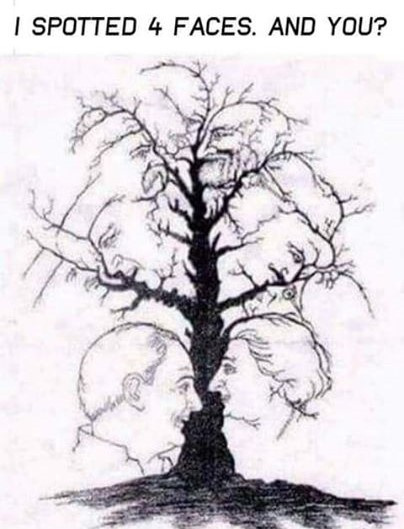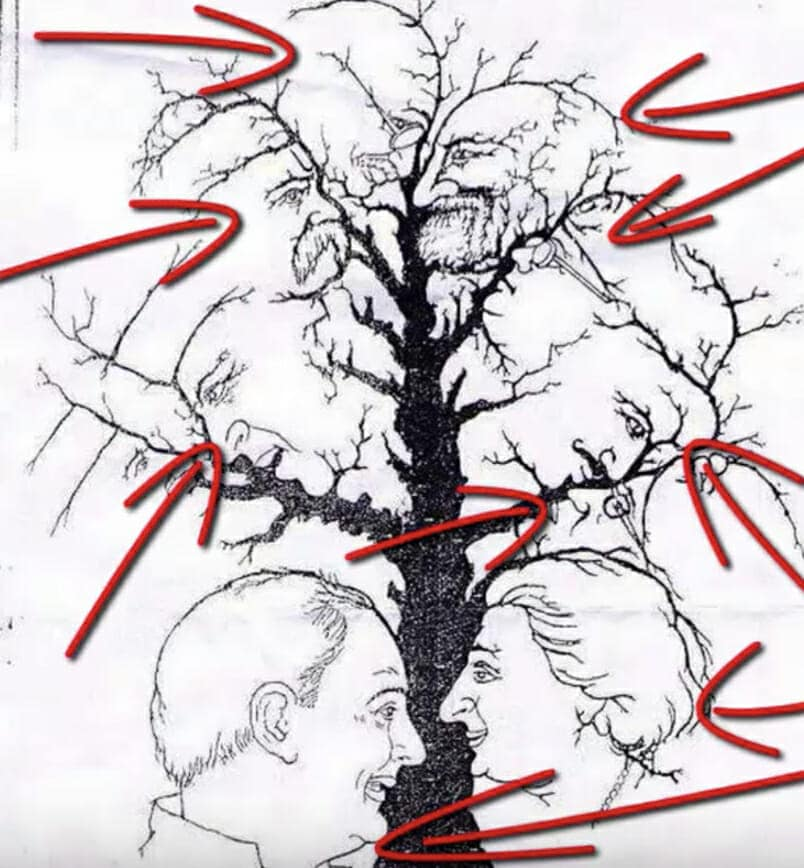Discover Hidden Faces in a Tree: Mastering Pareidolia and Optical Illusions
Unlock the Mystery: Why We See Faces in Trees
Have you ever glanced at a gnarled tree and suddenly “spotted” a face staring back at you? That delightful phenomenon stems from pareidolia—our brain’s natural tendency to find familiar patterns, especially faces, in random shapes. In the optical illusion above, a barren tree trunk and its twisting branches conceal at least four distinct human profiles. With a few simple strategies, you can train your eye to uncover every hidden visage and gain fresh appreciation for nature’s artful surprises.

The Psychology of Pareidolia: Why Faces Pop Out
Our brains evolved to detect faces instantly—a skill crucial for social interaction and survival. When you study an ambiguous image:
- Face Recognition Module: The fusiform face area (FFA) in your brain lights up whenever you process facial features, even in inanimate objects.
- Pattern Matching: Given visual ambiguity, your mind fills gaps, mapping eyes, noses, and mouths onto textured surfaces.
- Emotional Reward: Spotting a hidden face triggers dopamine release, offering a small “aha” delight that encourages you to keep searching.
Understanding this mental wiring explains why those twisting branches so readily morph into expressions of surprise, contemplation, or laughter.
Breaking Down the Four Faces: Step-by-Step Guide
Ready to spot all four hidden profiles? Here’s how:
- Start at the Base: Focus on the tree’s root flare. Notice two faces looking toward each other—an older man on the left and a woman on the right, their chins nearly touching at the trunk’s center.
- Scan the Mid-Trunk: Move your gaze upward to the thicker branch offshoots. On the trunk’s left side, you’ll find a third profile—a bearded face looking right, its mustache formed by a horizontal fissure.
- Examine the Upper Canopy: Near the top, the fifth major limb sweeps skyward. There, the bark’s undulations and small twigs sketch a fourth countenance—an elderly figure gazing upward, as if lost in thought.
- Use Peripheral Vision: Sometimes faces hide in negative space. Relax your eyes and let patterns emerge at the edges of your focus.
- Trace Contours with a Finger: Lightly run your fingertip along suspicious curves to visualize them as noses or brows.
By methodically scanning root, trunk, and branches, you’ll uncover every secret face woven into the woodgrain.

Techniques for Creating Your Own Face-in-Tree Illusions
Inspired to craft your own hidden-face artwork? Follow these creative steps:
- Select a Strong Silhouette: Use a robust tree trunk and bold outlines—thin, fragile shapes won’t support multiple faces.
- Map Key Profiles: Lightly sketch face outlines—side-profiles work best—ensuring each occupies a distinct section of the trunk or major limb.
- Merge Lines Seamlessly: Blend facial contours with natural bark fissures and branch junctions so they flow uninterrupted.
- Vary Scale and Orientation: Mix small faces near twig clusters with larger profiles on thicker limbs for dynamic visual interest.
- Refine with Shading: Add gentle cross-hatching to deepen eye sockets and highlight nose bridges, reinforcing the illusion without overpowering the tree texture.
- Test on Fresh Eyes: Show your draft to a friend—if they spot at least one face quickly but need hints for the rest, you’ve hit the perfect balance of concealment and clarity.

Exploring Nature’s Art Gallery: More Pareidolia Examples
Finding faces in trees is just the beginning. Everywhere you look, nature offers hidden surprises:
- Cloudscapes: Driftwood clouds often form animal shapes or human silhouettes against the sky.
- Rock Formations: Weathered cliffs and canyon walls reveal profiles of ancient faces or mythical creatures.
- Forest Floors: Leaf patterns and shadows can map out feline eyes, insect antennae, or avian beaks.
- Ice and Frost: Window frost sketches ephemeral woodland scenes and fairy faces on glass.
By training your mind to seek pareidolia, the world around you becomes an endless interactive gallery of hidden wonders.
Practical Benefits of Pareidolia Training
Beyond the fun of optical riddles, hunting for hidden faces offers real mental perks:
- Enhanced Observation Skills: You’ll notice subtle details in art, design, and daily life that others might miss.
- Creative Flexibility: Seeing multiple interpretations in one image nurtures divergent thinking—valuable in brainstorming and problem-solving.
- Mindful Awareness: Focusing on small patterns calms racing thoughts, promoting a meditative state and reducing stress.
- Artistic Inspiration: Pareidolia exercises spark new ideas for storytelling, illustration, and photography projects.
Integrating these playful exercises into your routine sharpens both your vision and imagination.

Conclusion: Celebrate the Magic in the Mundane
Next time you pass a windswept tree or gaze at a weathered wooden fence, pause and ask, “Who else is there?” By leveraging the power of pareidolia, you transform ordinary landscapes into captivating scenes teeming with hidden faces. Whether you’re a budding artist sketching your own illusions or simply seeking a moment of wonder, the hunt for nature’s secret silhouettes reminds us that beauty—and mystery—awaits in the most unexpected places. Happy face-spotting!





